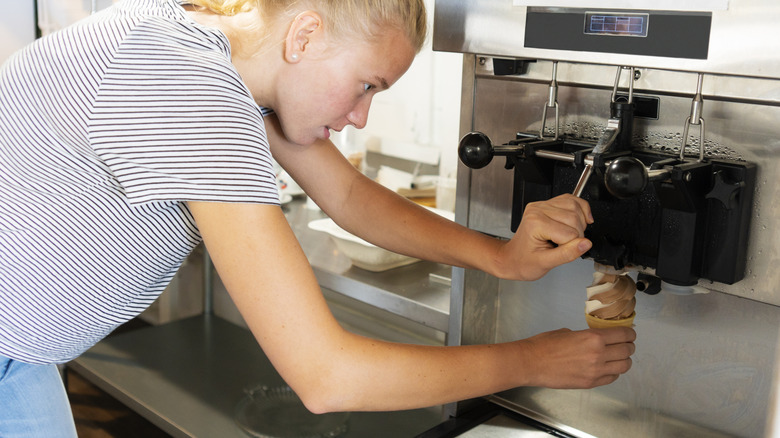Is Soft Serve Just Melted Ice Cream?
The world of ice cream is a vast one. Ice cream encompasses dozens of variations including gelato, sorbet, frozen custard, sherbet, frozen yogurt, ice milk, even tiny flash-frozen ice cream pellets (think Dippin' Dots). One of my favorites is soft serve, a type of ice cream that places like Dairy Queen and McDonald's (here's what theirs is made of) have built their dessert reputations on. Unlike hard custard-style ice cream which you often have to let soften up before you can take a decent lick, soft serve comes out soft and creamy and ready to dive in. Some folks even think soft serve ice cream is nothing but regular ice cream that's been slightly melted. However, this isn't the case.
To learn more about soft serve ice cream, we sat down with Neil Hershman, the CEO of 16 Handles, the mega-popular chain of soft serve and frozen yogurt shops that began in New York City and has since expanded across the east coast and into Florida and Texas. He explained, "Soft serve is designed to be mixed and served soft, so it's definitely not just melted ice cream. Rather than staying frozen in one place like standard ice cream, soft serve machines mix and freeze while dispensing product in order to create the perfectly creamy treat."
Each 16 Handles location has 16 rotating flavors of soft serve ice cream and frozen yogurt (is it really healthier than ice cream?) on any given day, with a dizzying array of toppings (over 50 choices, in fact) that customers help themselves to.
Air is a key factor in creating soft serve
Because a soft serve ice cream machine is constantly mixing the ingredients, plenty of air is also incorporated into the sweet treat, which creates a light, almost foamy-consistency as the ice cream is served. But, rest assured, you're not paying for air rather than ice cream at places like 16 Handles, where customers are charged by the weight of their creations.
Regarding the matter, Neil Hershman said, "It's actually to the customer's benefit to have air mixed in, as a cup looks fuller yet weighs less. There aren't regulations per se for soft serve sold by weight like there are with frozen pints, which are otherwise there to protect consumers from paying for empty weight or dead space from the grocery freezer." Furthermore, Hershman added, "Without air, the soft serve may look wet or fall over when swirled into a cone."
Another telling factor that soft serve is, indeed, not melted ice cream, is that the ingredients are different. Soft serve is generally made from milk, sugar, and non-egg stabilizers, while traditional ice cream often contains egg yolks. It is made of 3-6% butterfat, compared to traditional ice cream which has anywhere from 10-20% butterfat. In addition, while regular ice cream can be made, frozen, and shipped to locations, soft serve must be made on site and mixed-to-serve. It can't be premade and maintain its consistency.

